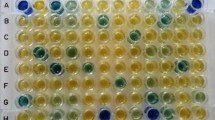Abstract
Thirty-one bradyrhizobial and rhizobial strains infecting pigeon pea were screened for siderophore production using Chrome Azurol S (CAS) agar plate as well as a CAS assay solution. Of a total of 31 strains only 23 showed siderophore production. Of the 23 siderophore-positive strains, 21 strains showed the production of hydroxamate while 6 strains showed the presence of catechol type of siderophore. A large variation in the quantity of hydroxamate and catechol produced by different rhizobial strains was observed (1.03–3.73 μg hydroxamate N per mg protein; 0.19–3.43 μmol/L of catechol per mg protein). Maximum nodule biomass was produced by strain PP-11 (CC-1020); strain G-14 formed minimum nodule biomass. Nitrogen contents of low, moderate and high siderophore-producing strains were 11.4, 15.4, 20.9 mg per plant, respectively, iron contents were 1445, 1768 and 2003 ppm, respectively. Siderophore production was related to N2-fixing efficiency.
Similar content being viewed by others
References
Ames-Gottfred N.P., Christie B.R., Jordan D.C.: Use of chrome azurol S agar plate technique to differentiate strains and field isolates ofRhizobium leguminosarum bv.trifolii.Appl. Environ. Microbiol. 55, 707–710 (1989).
Arnow L.E.: Colorimetric determination of the components of 3,4-dihydroxyphenylalanine-tyrosine mixtures.J. Biol. Chem. 118, 531–537 (1937).
Bremner J.M.: Determination of nitrogen in soil by Kjeldahl method.J. Agric. Sci. 55, 11–13 (1960).
Carson K.C., Holliday S., Glenn A.R., Dilworth M.J.: Siderophore and organic acid production in root nodule bacteria.Arch. Microbiol. 157, 264–271 (1992).
Crowley D.E., Reid C.P.P., Szaniszlo P.J.: Microbial siderophores as iron sources for plants, pp. 370–386 in G. Winkelmann, D. Van der Helm, J.B. Neilands (Eds):Iron Transport in Animals, Plants and Microorganisms. VCH Chemie, Weinheim (Germany) 1987.
Csaky T.Z.: On the estimation of bound hydroxylamine in biological materials.Acta Chem. Scand. 2, 450–454 (1948).
Dudeja S.S., Suneja S., Khurana A.L.: Iron acquisition system and its role in legume-Rhizobium symbiosis.Indian J. Microbiol. 37, 1–11 (1997a).
Dudeja S.S., Duhan J.S., Khurana A.L.: Siderophore mediated iron acquisition in rhizobia under free living and symbiotic condition in fragile environments, pp. 212–229 in R.K. Behl, A.P. Gupta, A.L. Khurana, A. Singh (Eds):resource Management in Fragile Environments. Chaudhary Charan Singh Haryana Agricultural University Hisar and Maxmuller Bhavan New Delhi 1997b.
Fabiano E., Gill P., Bagnasco P., Noya F., De la Fuente L., Arias A.:Rhizobium meliloti mutants defective in high-affinity iron acquisition, p. 401 in I.A. Tikhonovich, N.A. Provorov, V.I. Romanov, W.E. Newton (Eds):Nitrogen Fixation: Fundamentals and Applications. Kluwer Academic Publishers, Dordrecht-Boston-London 1996.
Fred L.B., Baldwin I.L., McCoy E.M.: Root nodule bacteria and leguminous plant.Wisconsin University Studies in Science, p. 18 (1932).
Guerinot M.L., Meidl E.J., Plessner O.: Citrate as a siderophore inBradyrhizobium japonicum.J. Bacteriol. 172, 3298–3303 (1990).
Modi M., Shah K.S., Modi V.V.: Isolation and characterization of catechol-like siderophores from cowpeaRhizobium RA-1.Arch. Microbiol. 141, 156–158 (1985).
Nambair P.T.C., Sivaramakrishnan S.: Detection and assay of siderophores in cowpea rhizobia using radioactive59Fe.Letter Appl. Microbiol. 4, 37–40 (1987).
Neilands J.B.: Microbial iron compounds.Ann. Rev. Biochem. 50, 715–731 (1981).
O'Hara G.W., Boonkerd N., Dilworth M.J.: Mineral constraints to nitrogen fixation.Plant & Soil 108, 93–110 (1988).
Patel V., Baxi M.D., Modi V.V.: Evidence for the involvement of iron siderophore in the transport of molybdenum in cowpeaRhizobium.Curr. Microbiol. 17, 179–182 (1988).
Piper C.S.:Soil and Plant Analysis, Hans Publisher, Bombay 1986.
Reigh G., O'Connell M.: Siderophore production is strain specific inRhizobium, p. 826 in H. Bothe, de F.J. Bruijn, W.E. Newton.Nitrogen Fixation 100 Years After. Fisher, Stuttgart 1988.
Robinson R.L., Postgate J.R.: Oxygen and hydrogen in biological nitrogen fixation.Ann. Rev. Microbiol. 34, 182–207 (1980).
Schwyn B., Neilands J.B.: Siderophores from agronomically important species ofRhizobiaceae.Comm. Agric. Food Chem. 1, 95–114 (1987).
Skorupska A., Derylo M., Lorkiewicz Z.: Siderophore production and utilization byRhizobium trifolii.Biol. Metals 2, 45–49 (1989).
Suneja S., Sharma P.K., Lakshminarayana K.: Production of hydroxamate type of siderophore byRhizobium sp. (Cicer).Indian J. Microbiol. 32, 181–183 (1992).
Suneja S., Yadav K.S., Sharma H.R.: Siderophore production by rhizobia.Crop Res. 8, 621–626 (1994).
Van Rossum D., Muyotcha A., Van Verseveld H.W.: Siderophore production byBradyrhizobium spp. strains nodulating groundnut.Plant & Soil 163, 177–187 (1994).
Wittenberg J.B., Wittenberg B.A., Day D.A., Udvardi M.K., Appleby C.A.: Siderophore bound iron in the peribacteroid space of soybean root nodules.Plant & Soil 178, 161–169 (1996).
Author information
Authors and Affiliations
Rights and permissions
About this article
Cite this article
Duhan, J.S., Dudeja, S.S. & Khurana, A.L. Siderophore production in relation to N2 fixation and iron uptake in pigeon pea-Rhizobium symbiosis. Folia Microbiol 43, 421–426 (1998). https://doi.org/10.1007/BF02818585
Received:
Revised:
Issue Date:
DOI: https://doi.org/10.1007/BF02818585




